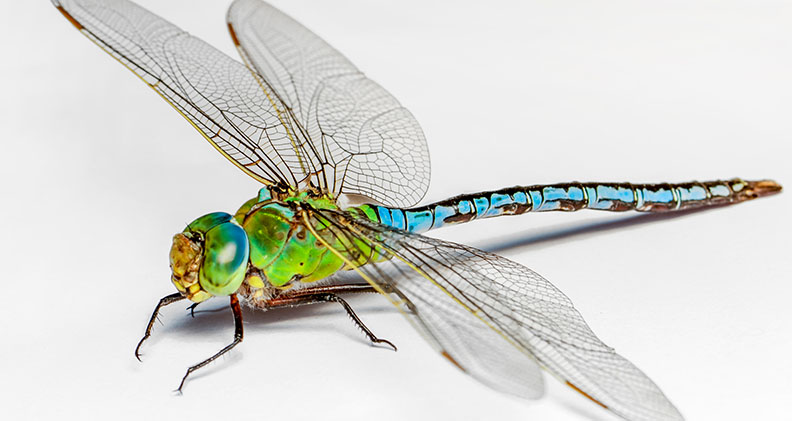
A research team at the University of Illinois at Urbana-Champaign developed a “smart” orthopedic implant coating modeled after the wings of dragonflies and cicadas. Their recent study, published in the journal Science Advances, demonstrated that the technology was successful in preventing infection in live mice and mapping implant strain in the spines of sheep.
Surgical infection and implant failure occur in about 10% of patients who receive orthopedic implants, according to Qing Cao, Ph.D., the research team’s leader and Professor of Materials Science and Engineering at the University of Illinois at Urbana-Champaign. Interventions often require implants and infected tissues to be surgically removed.
“The smart coating combines bio-inspired nanomaterial design with flexible electronics to address a complicated, long-term biomedical problem,” Dr. Cao said.
Dr. Cao’s team received a grant from the U.S. Department of Defense to address implant infections and failures. The team worked together to develop a prototype of the smart coating that was built with the latest developments in biomimetic nanomaterials and flexible electronics.
To construct the outer surface of the coating’s nanostructured foil, the team fabricated high-density arrays of nanopillars with optimized geometries that mimic the natural structures of cicada and dragonfly wings.
The smart coating does not use strong toxic chemicals or antibacterial drugs, which are known to quickly become ineffective. Instead, it relies on its physical structure to prevent infection. “The nanopillars punch through bacterial cell membranes and kill bacteria on contact,” Dr. Cao said.
The coating prevents pathogenic bacteria from attaching to the surface of implants. “Compared to previous efforts that were mainly based on the slow release of antibiotics, our device kills the bacteria based on a purely physical process,” Dr. Cao said. “It will not cause or suffer from drug resistance. It does not have any toxic side effects on human cells, tissues and organs.”
Dr. Cao touted the technology’s ability to adhere to implants and kill bacteria, preventing them from developing into biofilm. “This functionality was verified in both superficial and implant infection mouse models,” he said. “Implant infections are very difficult to treat, typically requiring surgical revisions to replace the implant and remove the affected surrounding tissues.”
Using a mechanical approach to killing bacteria allowed the researchers to bypass many of the problems associated with chemical approaches, according to Gee Lau, Ph.D., a coauthor of the study. It also allowed for the flexibility that was needed to apply the coating to implant surfaces.
The back side of the nanostructured foil that contacts an implant’s surface was constructed with flexible electronics. These multiplexing electronics comprised highly sensitive strain sensors and were built on an ultrathin single-crystalline silicon nanomembrane.
“Single-crystalline silicon is usually rigid and brittle. Reducing its thickness to one-thousandth the width of a human hair makes it flexible,” Dr. Cao said. “This flexibility makes it suitable for application to the curved surfaces of implants. We built electronic control circuits on ultrathin silicon membranes to enable mapping strain distribution over the entire implant.”
Strain applied to the implant modulates the electronic structure of the silicon and changes its conductivity, Dr. Cao explained. “The strain distribution along the surface of the implant can then be precisely determined,” he added, “even with changes below 0.1%.”
The precise monitoring of strain distribution on implants provides an early and direct diagnosis of device failure. The smart coating’s ultrathin single-crystalline silicon membrane sensors are 25 times more sensitive than metal foil strain sensors used in other devices.
The coating allows for the remote measuring of strain distribution, a functionality the researchers verified in a sheep posterolateral spinal fusion model. Dr. Cao said the remote measuring of strain on implants could allow surgeons to monitor the healing progress of their patients and develop personalized rehabilitation strategies to accelerate recoveries.
“It also provides early diagnosis of implant failure,” he added. “Currently, patients must undergo imaging to get indirect information regarding their healing progress and the potential for device failure. The process is inaccurate, expensive and subjects patients to radiation exposure.”
Dr. Cao’s team will begin testing the smart coating on larger animal models, such as sheep and goats, with skeletal properties similar to humans. “If everything goes well, we will then test the technology in humans,” he said. “It will probably take several years before we can complete these experiments and meet FDA’s regulatory requirements. Our current target is to make the coating available for clinical use by 2029.”
PM
Patrick McGuire is a BONEZONE Contributor.




